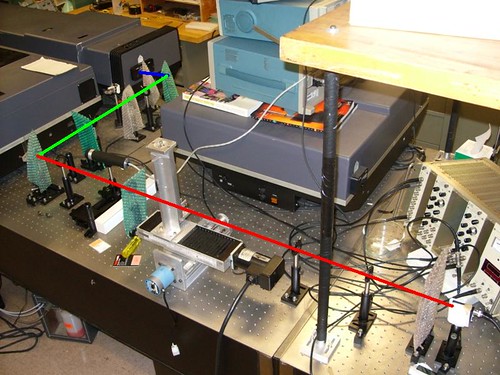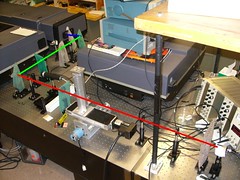Now, here is the path of the laser:

The blue part shows the path of laser after exiting the laser housing (inside which also reside the laser amplifier and the second harmonic generating KDP crystal), the green part shows how the beam is moved to the other end of table, and during this part the laser beam is attenuated to meet the experiment's requirements, and the red leg of the journey shows the part of the beam used not just for taking beam energy readings (see the energy meter's reading head to the top right of the red leg), but also the z-scan readings.
To align the beam the mirror at the blue-green intersection is moved until the beam hits the first aperture on the red leg dead on, and then the mirror at the green-red intersection is moved until the beam hits the second last aperture dead on (we try not to touch the last aperture, as its diameter will effect our scan results).
Now, all the alignment assumes that we have a gaussian shaped circular beam (this is accomplished by tuning the laser cavity properly, and then by carving out any unwanted portions of the beam using the first aperture in the red leg of the beam). If we have a TE01, or a TE10 beam, then we are not to use such a beam. A roughly circular beam may be carved into a more circular beam (if it has a halo of some shape, to one side, then that may be carved out, too), and used in z-scan experiments. At first, we kept getting what looked like a TE01 beam,
(see: My z-scan is still misbehaving)
but it turned out that that problem was caused by a faulty polarizing filter (in the green leg), which I promptly removed.
The problem that we are facing, right now, is that while our beam looks circular, it also looks like most of the energy is concentrated along a crescent along one edge of the beam -- kind of like when you can see a crescent moon, at night, but can see a halo like glow that betrays the existence of the whole of the moon's disk, though, I exaggerate. So, no matter how well we align the beam, I simply do not think that we will get a z-scan (and, right now, we are not getting a z-scan). So, while I am not sure what exactly I should do, I am thinking that I should go back to the laser, optimize the laser cavity (finding the global maximum of the peak beam intensity, for all the possible back mirror positions), then put in the aperture, and then scan through all the possible positions to find that global maximum for the photon content of the cavity, and then, hopefully, I will have a beautiful, gaussian, laser beam.
Another, perhaps crazy, idea that I am having is finding another aperture (smaller than the one we are using inside our laser cavity), and taping it over the current one -- or, maybe, I can talk my professors into buying a smaller aperture, at a later time.
I am sure that my problem with the notorious crescent is not something new in the field of z-scans -- the technique has been around for a while, now, so I am sure I am not the first person to encounter this problem. While I have not found any blogs, or stories, by anyone who has solved this problem, I am hoping that when I am done with this issue my story will benefit those who have this problem after me. No sense suffering in silence (keeping the world in the dark), and dying in pain (perishing, by failing to publish)-- there is no sense in playing the MIBs (or anyone who gets in, gets the job done, and leaves without a trace, with no one knowing that he/she was even there) from the Will Smith/Tommy Lee Jones movie Men in Black. Afterall, as a scientist, you are really a part a whole much larger than yourself, and your own private dreams. As an engineer, or a scientist, you have the rest of your team, or community, actually depending on you, rather than just waiting for the job to get done, without a care for you (yeah Ejovi Nuwere, author of Hacker Cracker, is a real inspiration). It makes much more sense to be heard, and helped, if only to help someone else.

No comments:
Post a Comment